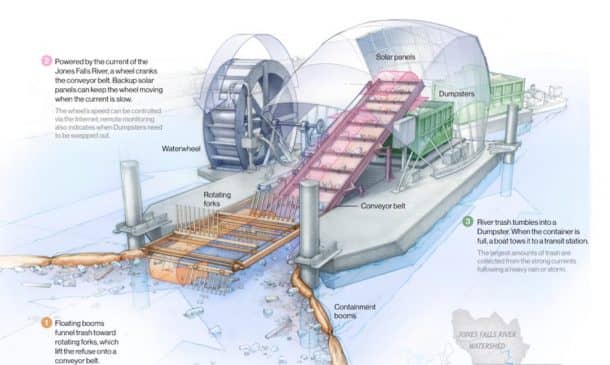Who said that you cannot save the world by being as cute as a button? Mr. Trash Wheel is an example of such a superhero who is adorable with its wide puppy dog googly eyes, a snail-like shape, and an open mouth. Beyond its lovable attire, it is a solar and hydro-powered trash interceptor built to gnaw at Baltimore’s Inner Harbor’s plastic bags, Styrofoam containers, cigarette butts, and other debris in a bid to make it clean enough to swim in.
The idea was initially pitched by a local sailor and engineer John Kellett, who approached the city while looking to solve the epidemic of pollution after watching tons of debris floating in the Inner Harbor. The motivation led to a promising but inadequate first trash wheel, after which the project was supported by the Water Partnership of Baltimore resulting in the creation of Mr. Trash Wheel.

Mr. Trash Wheel has been made to look adorable and fuzzy to appeal to the ethos of the people around thus, drawing more attention towards its cause. “He” also has his Twitter account, where regular updates on the trash stats are given. Mr. Trash Wheel uses solar panels and goes with the river’s flow to turn the massive waterwheel, which then moves the conveyor belt. The trash is sucked up by floating containment booms which are picked up by rotating forks before it is thrown on the conveyor belt and deposited into the dumpster. Once the trash can is full, it is emptied into a transit station where Mr. Trash Wheel continues his trash munching.
After a few months of successful operations, Mr. Trash Wheel felt lonely in his battle against pollution. Thus, Kellett and the Water Partnership raised more funds and made a female version: Professor Trash Wheel. The professor is deployed in another debris ridden part of the Inner Harbor, chugging up on scores of trash coming from illegal dumping, cigarette butts stubbed out on the ground and trash chucked from cars.

Since the Trash Wheel rolled out in 2014, it has picked up over a million pounds of trash from the Jones Fall River, thus, filling an average of 70-100 dumpsters every year. Their statistics show that the trash wheel has picked up to 300,000 plastic bags, 6,000 glass bottles, and nine million cigarette butts. The combustible trash is used to generate electricity.
The city is now looking to deploy a couple of new trash wheels to achieve their goal of making the harbor suitable for fishing and swimming by 2020. Besides, Kellett is also planning on placing the wheel on multiple sites such as Rio de Janeiro, Honolulu, and Denver. But even though the wheel is a success, yet, the only sustainable solution to curbing out the scourge of pollution is to apply environmental regulations and raise more awareness among the masses about the merits of keeping their surroundings clean.
We would appreciate your valuable feedback in the comments’ section below!


